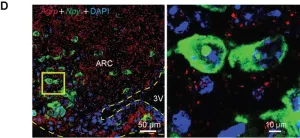(Press-News.org) A team at the Garvan Institute of Medical Research has discovered a group of brain cells that boosts appetite when there is a prolonged surplus of energy in the body, such as excess fat accumulation in obesity.
The researchers discovered that these cells not only produced the appetite-stimulating molecule NPY, but they in fact made the brain more sensitive to the molecule, boosting appetite even more.
“These cells kickstart changes in the brain that make it more sensitive to even low levels of NPY when there is a surplus of energy in the body in the form of excess fat – driving appetite during obesity,” explains Professor Herbert Herzog, senior author of the study and Visiting Scientist at Garvan.
“Our study addresses a long-standing question about how appetite is controlled in obesity and has the potential to take the development of therapy into a new direction.”
The research was published in the journal Cell Metabolism.
The discovery of a vicious cycle
Obesity is a major public health issue and a disease that affects more than one in 10 adults and increases a person’s risk of developing other chronic conditions, such as diabetes or heart disease. While many factors can influence the development of obesity – an excessive accumulation of fat tissue in the body – eating patterns and physical activity levels are key contributors.
“Our brain has intricate mechanisms that sense how much energy is stored in our body and adjust our appetite accordingly. One way it does this is through the molecule NPY, which the brain produces naturally in response to stresses, such as hunger, to stimulate eating,” says Professor Herzog.
“When the energy we consume falls short of the energy we spend, our brain produces higher levels of NPY. When our energy intake exceeds our expenditure, NPY levels drop and we feel less hungry. However, when there is a prolonged energy surplus, such as excess body fat in obesity, NPY continues to drive appetite even at low levels. We wanted to understand why.”
In mouse models of obesity, the researchers investigated cells in the brain called neurons that produced NPY and discovered that surprisingly, 15% of them were different – they did not shut down NPY production during obesity.
“We found that under obese conditions, appetite was mostly driven by NPY produced by this subset of neurons. These cells did not only produce NPY, but also sensitised other parts of the brain to produce additional receptors or ‘docking stations’ for the molecule – supercharging appetite even further,” says Professor Herzog.
“What we have uncovered is a vicious cycle that disrupts the body’s ability to balance its energy input with energy storage and enhances obesity development.”
Wired to resist weight loss
“Our brain is wired to resist energy deficiency or weight loss, as it sees this as a threat to our survival and kickstarts mechanisms that increase our appetite so that we seek out food. As we found now, this even occurs when we have excess energy stored in the body,” Professor Herzog explains.
The researchers say their discovery opens the possibility of blocking the additional, more sensitised receptors for NPY as a new approach to developing anti-obesity medication.
“Our discovery helps us better understand the mechanisms in the brain that interfere with a balanced energy metabolism and how they may be targeted to improve health,” says Professor Herzog.
--ENDS--
This research was supported by the National Health and Medical Research Council (project grant 1144819). Professor Herzog is a Conjoint Professor at St Vincent's Clinical School, Faculty of Medicine and Health, UNSW Sydney.
END
Researchers pinpoint brain cells that drive appetite in obesity
2023-05-17
ELSE PRESS RELEASES FROM THIS DATE:
Receipt of medications for chronic disease during the first 2 years of COVID-19
2023-05-17
About The Study: This study of 18.1 million beneficiaries of fee-for service Medicare found that, in contrast to in-person health services, receipt of medications for chronic conditions was relatively stable in the first 2 years of the COVID-19 pandemic overall, across racial and ethnic groups, and for community-dwelling patients with dementia. This finding of stability may hold lessons for other outpatient services during the next pandemic.
Authors: Nancy E. Morden, M.D., M.P.H., of the Geisel ...
Genetic associations between modifiable risk factors and Alzheimer disease
2023-05-17
About The Study: This genetic association study including 39,000 participants with clinically diagnosed Alzheimer disease (AD) and 401,000 control participants without AD found novel genetic associations between high high-density lipoprotein (HDL) cholesterol concentrations and high systolic blood pressure with higher risk of AD. These findings may inspire new drug targeting and improved prevention implementation.
Authors: Ruth Frikke-Schmidt, M.D., D.M.Sc., Ph.D., of Copenhagen University Hospital–Rigshospitalet in Copenhagen, is the corresponding author.
To access the embargoed study: Visit our For The Media website at this link https://media.jamanetwork.com/
(doi:10.1001/jamanetworkopen.2023.13734)
Editor’s ...
Radio signal reveals supernova origin
2023-05-17
In the latest issue of the journal Nature, astronomers from Stockholm University reveal the origin of a thermonuclear supernova explosion. Strong emission lines of helium and the first detection of such a supernova in radio waves show that the exploding white dwarf star had a helium-rich companion.
Supernovae of Type Ia are important for astronomers since they are used to measure the expansion of the Universe. However, the origin of these explosions has remained an open question. While it is established that the explosion is that of a compact ...
Are Earth and Venus the only volcanic planets? Not anymore.
2023-05-17
Imagine an Earth-sized planet that’s not at all Earth-like. Half this world is locked in permanent daytime, the other half in permanent night, and it’s carpeted with active volcanoes. Astronomers have discovered that planet.
The planet, named LP 791-18d, orbits a small red dwarf star about 90 light years away. Volcanic activity makes the discovery particularly notable for astronomers because volcanism facilitates interaction between a world’s interior and its exterior.
“Why is volcanism important? It is the major source contributing to a planetary atmosphere, and with an atmosphere you could have surface liquid water — a requirement for sustaining ...
A channel involved in pain sensation can also suppress it
2023-05-17
Pain is good. It’s the body’s way to keep an animal from harming itself or repeating a dangerous mistake. But sometimes the debilitating sensation can get in the way. So evolution has devised ways to tamp that response down under certain circumstances.
Researchers at UC Santa Barbara identified the pathway in fruit flies that reduces the sensation of pain from heat. Remarkably, just a single neuron on each side of the animal’s brain controls the response. What’s more, the molecule responsible for suppressing ...
Genetic research offers new perspective on the early evolution of animals
2023-05-17
A study published by MBARI researchers and their collaborators today in Nature provides new insights about one of the earliest points in animal evolution that happened more than 700 million years ago.
For more than a century, scientists have been working to understand the pivotal moment when an ancient organism gave rise to the diverse array of animals in the world today. As technology and science have advanced, scientists have investigated two alternative hypotheses for which animals—sponges or comb jellies, also known as ctenophores—were most distantly related to all other animals. Identifying this outlier—known as the sibling ...
Research spotlight: a conversational artificial intelligence program can generate credible medical information in response to common patient questions
2023-05-17
What was the question you set out to answer with this study?
ChatGPT, a new language processing tool driven by artificial intelligence (AI), provides conversational text responses to questions and can generate valuable information for enquiring individuals, but the quality of ChatGPT-generated answers to medical questions is currently unclear.
What Methods or Approach Did You Use?
We retrieved eight common questions and answers about colonoscopy from the publicly available webpages of three randomly-selected hospitals from the top-20 list of the US News & World Report Best Hospitals for Gastroenterology and Gastrointestinal Surgery.
We ...
How breast cancer arises
2023-05-17
In what may turn out to be a long-missing piece in the puzzle of breast cancer, Harvard Medical School researchers have identified the molecular sparkplug that ignites cases of the disease currently unexplained by the classical model of breast-cancer development.
A report on the team’s work is published May 17 in Nature.
“We have identified what we believe is the original molecular trigger that initiates a cascade culminating in breast tumor development in a subset of breast cancers that are driven by estrogen,” said study senior investigator Peter Park, professor of ...
Astronomers find potentially volcano-covered Earth-size world
2023-05-17
Cambridge, Mass. – Astronomers have discovered an Earth-size exoplanet, a world beyond the solar system, that may be carpeted with volcanoes and could potentially support life. Called LP 791-18 d, the planet could undergo volcanic outbursts as often as Jupiter’s moon Io, the most volcanically active body in the solar system.
The planet was first reported in Nature and the discovery was made possible in part due to ground-based observations made by the Center for Astrophysics | Harvard & Smithsonian.
LP 791-18 d orbits a small red dwarf star about 90 light-years away in a southern constellation called Crater. The ...
Vigorous exercise not tied to increased risk of adverse events in rare heart condition
2023-05-17
Vigorous exercise does not appear to increase the risk of death or life-threatening arrhythmia for people with hypertrophic cardiomyopathy (HCM), according to a study supported by the National Institutes of Health. HCM is a rare, inherited disorder that causes the heart muscle to become thick and enlarged and affects 1 in 500 people worldwide. It has been associated with sudden cardiac death in young athletes and other young people. However, the study, published in JAMA Cardiology, found that people with the disease who exercise vigorously are no more likely to die or experience severe cardiac events than those who exercised moderately ...






